Hongcun Scenic Area is located in Hongcun Town, Yixian County, Huangshan City, Anhui Province, covering an area of 19.11 hectares. It is a Traditional Chinese Village, a Famous Historical and Cultural Village in China, and a Major National Historical and Cultural Site Protected at the National Level. In December 2000, as part of the Ancient Villages in Southern Anhui, Hongcun was inscribed on the UNESCO World Heritage List; in May 2011, it was awarded the title of "National 5A-Level Tourist Attraction" by the China National Tourism Administration. Hongcun preserves 137 ancient buildings from the Ming and Qing dynasties, including 3 ancestral halls and 124 well-preserved ancient residences. Buildings such as Chengzhi Hall and Nanhu Academy possess extremely high historical and artistic value, and Hongcun is hailed as "A Village in Chinese Paintings."
History and Culture
Hongcun was first founded in the first year of Shaoxing in the Southern Song Dynasty (1131 AD) and has a history of nearly 900 years. During the Southern Song Dynasty, Wang Yanji, the ancestor of Hongcun, moved his family upstream along the river from Qishu Village in Yixian County to build houses near Leigang Mountain after suffering a fire, gradually forming the village. During the Yongle reign of the Ming Dynasty, Wang Siqi, the 76th-generation ancestor of Hongcun, invited He Keda, a feng shui master from Haiyang County (now Xiuning County), three times to survey and plan the village. He diverted water from the West Stream into the village, dug irrigation canals, and built Moon Marsh, forming the initial village water system.
The planning and construction of Hongcun were deeply influenced by Huizhou culture and feng shui theory, with the entire village layout resembling a lying ox. Leigang Mountain serves as the ox's head, the two ancient trees at the village entrance as the ox's horns, the dense row of residences in the village as the ox's body, Moon Marsh as the ox's stomach, Nanhu Lake as the ox's belly, the winding water canals as the ox's intestines, and the four ancient bridges as the ox's legs, forming a complete ox-shaped village pattern. This "bionic" village planning is a model of traditional Chinese village construction.
Hongcun boasts profound cultural heritage and is home to many intangible cultural heritages such as Huizhou architecture and traditional Huizhou residence construction techniques. During the Ming and Qing dynasties, after becoming wealthy through business outside their hometown, the Wang clan of Hongcun returned one after another to build residences, ancestral halls, and academies, forming a large-scale complex of ancient buildings that reflects the Huizhou merchants' cultural pursuit of "valuing scholarship while engaging in commerce."
Major Attractions
Nanhu Lake
Located at the southern end of Hongcun, Nanhu Lake was dug in the 35th year of Wanli in the Ming Dynasty (1607 AD) with an area of approximately 2 hectares. The lake is crescent-shaped, and a dyke divides it into upper and lower parts. There are six stone bridges on the dyke, known as the "Six Bridges," which were built in imitation of the Su Causeway of West Lake in Hangzhou. Surrounded by towering ancient trees, Nanhu Lake presents a beautiful blend of lake scenery and mountain views, making it one of the most picturesque spots in Hongcun and a popular sketching base for students from many art colleges and universities.
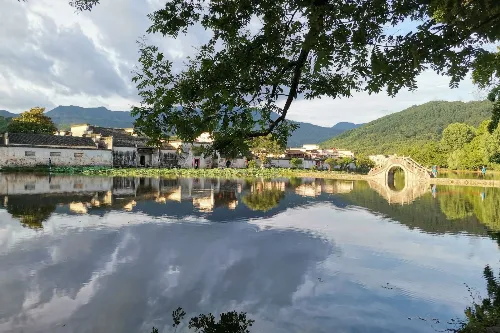
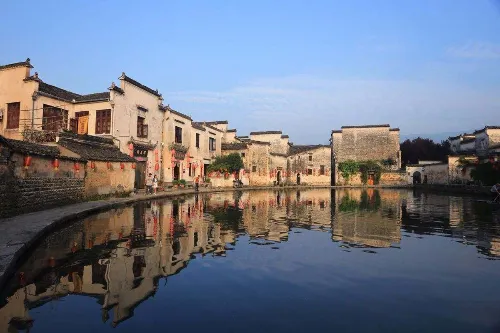
Moon Marsh
Located in the center of Hongcun, Moon Marsh was dug during the Yongle reign of the Ming Dynasty with an area of approximately 1,300 square meters. As a crescent-shaped pond, it embodies the concept of "when the moon is full, it begins to wane" in traditional Chinese culture, conforming to the thought of "the mean." The ancient buildings along the marsh stand in dense rows, with their white walls and black tiles reflecting in the water like a static ink wash painting. Most of the buildings around Moon Marsh are ancestral halls and important residences, making it the core area of Hongcun.
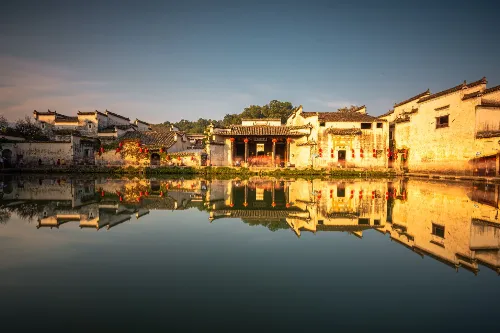
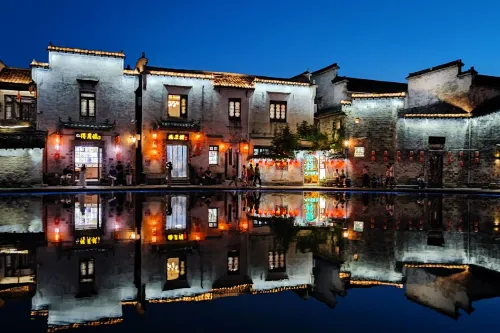
Chengzhi Hall
Located in the middle section of Hongcun, Chengzhi Hall was built in the fifth year of Xianfeng in the Qing Dynasty (1855 AD) and is the largest and most exquisitely decorated residence in Hongcun. Covering a total area of 2,100 square meters with a construction area of over 3,000 square meters, it features 9 courtyards, 7 floors, and 60 rooms. The wood carvings, stone carvings, and brick carvings in Chengzhi Hall are of exquisite craftsmanship. In particular, the wood carving "Emperor Suzong of Tang Feasting Guests" on the crossbeam of the front hall, with vivid figures, is one of the masterpieces of Huizhou wood carving.
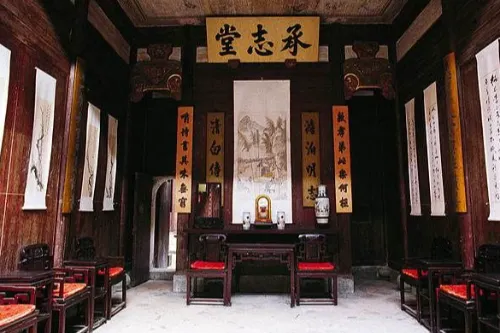
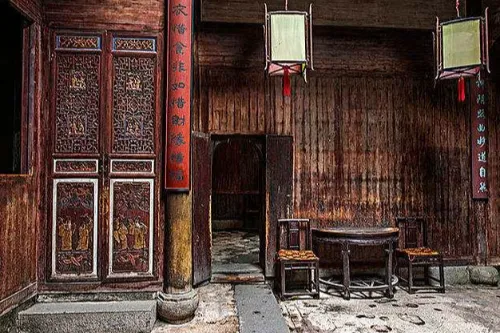
Nanhu Academy
Located by Nanhu Lake, Nanhu Academy was built in the 19th year of Jiaqing in the Qing Dynasty (1814 AD) with funds raised by the Wang clan of Hongcun as a private school. Composed of buildings such as Zhidao Hall, Wenchang Pavilion, Huiwen Pavilion, Qimeng Pavilion, and Wanghu Tower, the academy covers an area of approximately 6,000 square meters. With a quiet environment, facing Nanhu Lake in the front and leaning against Leigang Mountain in the back, it is an ideal place for studying and scholarly pursuits. Many children of Hongcun studied here, among whom many achieved academic success or became wealthy through business.
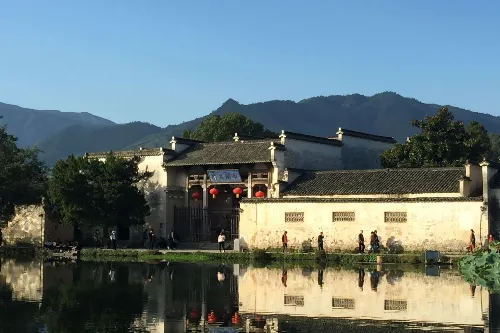
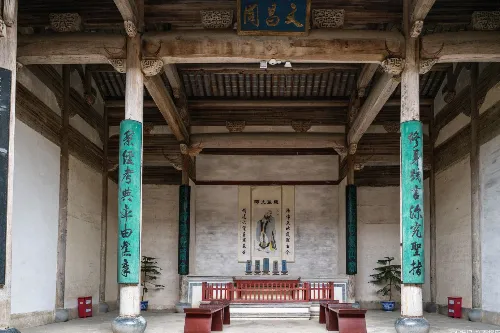
Wang Clan Ancestral Hall
Also known as "Lexu Hall," the Wang Clan Ancestral Hall is located north of Moon Marsh in Hongcun. Built during the Yongle reign of the Ming Dynasty, it is a place for the Wang clan of Hongcun to worship their ancestors. Covering an area of approximately 2,000 square meters with a construction area of 1,300 square meters, it consists of a gate archway, courtyard, patio, and main hall. The main hall is spacious and bright, enshrining the memorial tablets of the Wang ancestors. The beams and columns in the hall are thick and exquisitely carved, reflecting the architectural style of Huizhou ancestral halls.
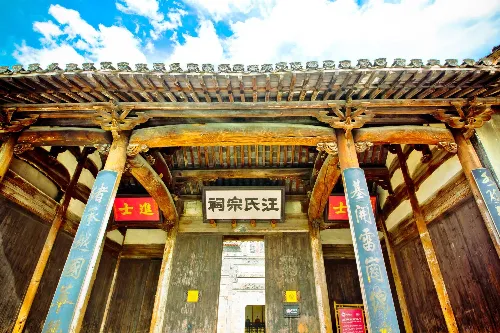
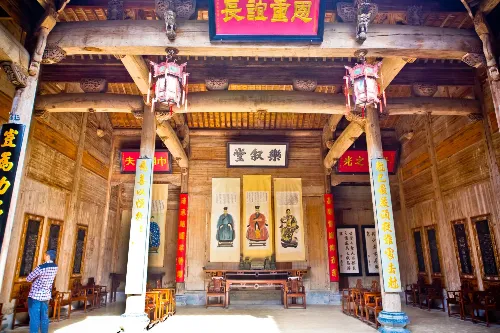
Shuren Hall
Located in the middle of Hongcun, Shuren Hall was built in the first year of Tongzhi in the Qing Dynasty (1862 AD) as the residence of Wang Xingju, a wealthy merchant in Hongcun. Covering an area of approximately 800 square meters with a construction area of over 1,000 square meters, it has 4 courtyards and 26 rooms. The wood carvings, stone carvings, and brick carvings in Shuren Hall are beautifully decorated. In particular, the indoor wood carving "One Hundred Boys" symbolizes prosperity with many children and grandchildren, making it a fine work of Huizhou wood carving.
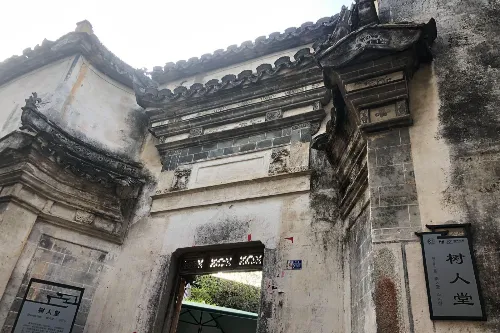
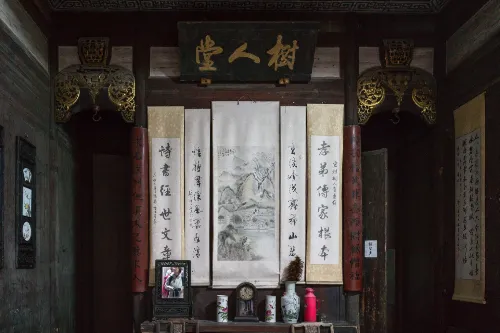
Jingxiu Hall
Located west of Moon Marsh in Hongcun, Jingxiu Hall was built during the Qianlong reign of the Qing Dynasty and is one of the well-preserved ancient residences in Hongcun. Covering an area of approximately 600 square meters with a construction area of over 800 square meters, it has 2 courtyards and 16 rooms. The brick carvings on the gate tower of Jingxiu Hall are exquisite, and the indoor furnishings are simple and elegant, reflecting the Huizhou merchants' cultural philosophy of "cultivating oneself and governing the family."

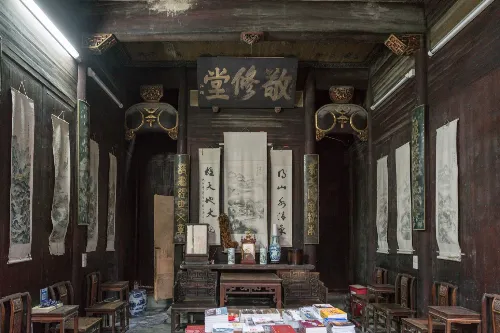
Deyi Hall
Located in the northwest of Hongcun, Deyi Hall was built during the Guangxu reign of the Qing Dynasty and is a typical Huizhou-style private garden residence. Covering an area of approximately 400 square meters with a construction area of over 500 square meters, it has 2 courtyards and 12 rooms. The courtyard layout of Deyi Hall is exquisite, with ponds, rockeries, and flowers and trees in the garden, creating a quiet environment. It is one of the few ancient residences in Hongcun with garden landscapes.
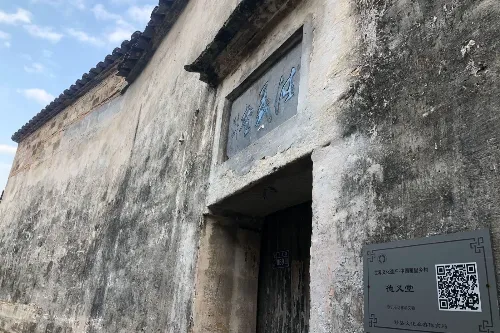
Jicun Street
Located north of Hongcun, Jicun Street is a commercial street with many shops, inns, and restaurants lined along both sides. Retaining the traditional Huizhou architectural style, the street features winding bluestone slab roads, making it an ideal place for tourists to experience the local customs and traditions of Hongcun.
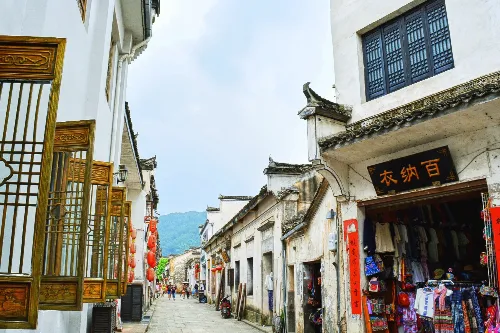
Tour Route
After entering the scenic area, tourists can start their tour from Nanhu Lake to admire the lake and mountain scenery as well as the ancient architecture of Nanhu Academy. Then proceed to Moon Marsh to visit the Wang Clan Ancestral Hall and the ancient residences around the marsh, immersing themselves in the core cultural atmosphere of Hongcun. Next, tour Chengzhi Hall to appreciate the exquisite wood carvings, stone carvings, and brick carvings of Huizhou architecture. Afterwards, visit ancient residences such as Shuren Hall and Jingxiu Hall to learn about the residential culture of Hongcun. Finally, go to Jicun Street to taste the local delicacies of Hongcun and purchase souvenirs. The recommended total tour time is 3-5 hours. For a deeper experience of Hongcun's night view and folk culture, tourists can choose to stay overnight in Hongcun and participate in night tour activities.
Travel Tips
- Learn about Huizhou architecture and the historical and cultural background of Hongcun in advance to better appreciate the scenic area's architecture and cultural landscapes.
- Visit on weekdays or during the off-season to avoid tourist peaks, allowing for a more leisurely tour of the ancient village and a chance to experience its tranquil atmosphere.
- Hire a local guide to gain an in-depth understanding of the stories and cultural connotations behind each attraction.
- Wear comfortable shoes, as the roads in Hongcun are mostly paved with bluestone slabs and involve a lot of walking during the tour.
- If time permits, it is recommended to stay overnight in Hongcun to experience the ancient village's morning and night scenes, and participate in night tour activities for a different atmosphere.
- Hongcun is a paradise for art sketching. If interested in painting, bring painting tools to sketch by Nanhu Lake, Moon Marsh, and other scenic spots.
Notes
- Most ancient buildings in the scenic area have a long history. Please do not touch, climb, or damage them to avoid irreversible losses.
- Respect local customs, traditions, and religious beliefs. Do not make loud noises or engage in inappropriate behaviors in ancestral halls and other venues.
- When purchasing souvenirs and local snacks, pay attention to distinguishing quality and price to avoid being overcharged.
- Protect the environment by not littering, and maintain the cleanliness and beauty of the ancient village.
- Follow the instructions of scenic area staff during the tour, abide by the scenic area's regulations, and do not enter unopened areas without permission.
- The roads in Hongcun Scenic Area are narrow, and there is a large flow of tourists during the peak season. Please pay attention to safety and take good care of the elderly and children.
- When visiting in summer, take precautions against sun exposure and heatstroke. There are many trees around Hongcun, so you can also bring mosquito repellent products.
Transportation
- By Air: First arrive at Huangshan Tunxi International Airport, which is about 80 kilometers away from Hongcun. You can take a shuttle bus from the airport to Yixian County, then transfer to another shuttle bus to Hongcun, with a total travel time of about 1.5 hours. Alternatively, you can take a taxi directly from the airport to Hongcun, costing about 200 yuan.
- By Train: Take the train to Huangshan Station or Huangshan North Station. Huangshan Station is about 70 kilometers away from Hongcun; you can transfer to a shuttle bus to Yixian County, then switch to a bus to Hongcun, taking about 1.5 hours. Huangshan North Station is about 60 kilometers away from Hongcun, and you can also transfer to a shuttle bus to Yixian County first, then to Hongcun.
- By Self-Driving: Depart from Huangshan City, drive along G56 Hangrui Expressway to Yixian County Exit, then follow the navigation to Hongcun. The total distance is about 60 kilometers, and the travel time is about 1 hour. If departing from other cities, you can navigate to Yixian County first, then proceed to Hongcun. The scenic area has a parking lot with a fee of about 15 yuan per day.
- By Coach: There are shuttle buses to Hongcun from multiple bus stations in Huangshan City. Among them, Huangshan Passenger Transport Terminal operates about 10 daily departures to Hongcun, with a travel time of about 1.5 hours and a ticket price of about 25 yuan.
Opening Hours
Regular opening hours: 7:30-17:30; Night tour opening hours: 18:30-21:00 (some attractions are not open during the night tour). The opening hours may be adjusted due to seasonal changes, weather conditions, etc.
Ticket Information
Ticket price: 94 yuan per person.
You can search for the official WeChat public account "宏村动态" to get the latest updates or purchase tickets online.
Online Booking
Click here to jump to the Trip.com ticketing platform for ticket purchase.


